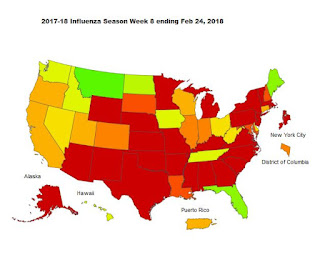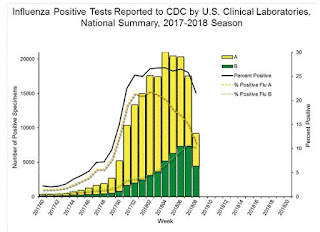#13,184
While the high level of influenza seen in January and February has begun to decline, the level of influenza-like-Illness (ILI) remains elevated across much of the country, and is roughly what we would expect to see near the peak of a `normal' flu season.
Several more states have reported reductions in ILI (see map below), but much of the Midwest, the deep South, and Mid-Atlantic regions continue to report high levels of ILI activity.
This year's record number of flu-related hospitalizations continues its ascent, with the overall rate reaching 81.7 per 100,000 population. Those over 65 are the hardest hit (350.7 per 100,000 population), followed by adults aged 50-64 (88.5 per 100,000 population) and children aged 0-4 years (57.8 per 100,000 population).
While overall flu has declined, influenza B continues to gain ground this week, making up 45.8% of viruses subtyped.
Lastly the CDC reports another 17 pediatric flu-related deaths, making a total of 114 influenza-associated pediatric deaths reported for the 2017-2018 season. As reporting is often delayed by several weeks, this number is likely to rise over the next month or so.
Some excerpts from the summary of today's FluView report follow:
2017-2018 Influenza Season Week 8 ending February 24, 2018
All data are preliminary and may change as more reports are received.Synopsis:
During week 8 (February 18-24, 2018), influenza activity decreased in the United States.
- Viral Surveillance: While influenza A(H3) viruses continue to be predominant this season, during week 8 the overall proportion of influenza A viruses is declining and the proportion of influenza B viruses is increasing. The percentage of respiratory specimens testing positive for influenza in clinical laboratories decreased.
- Pneumonia and Influenza Mortality: The proportion of deaths attributed to pneumonia and influenza (P&I) was above the system-specific epidemic threshold in the National Center for Health Statistics (NCHS) Mortality Surveillance System.
- Influenza-associated Pediatric Deaths: Seventeen influenza-associated pediatric deaths were reported.
- Influenza-associated Hospitalizations: A cumulative rate of 81.7 laboratory-confirmed influenza-associated hospitalizations per 100,000 population was reported.
- Outpatient Illness Surveillance:The proportion of outpatient visits for influenza-like illness (ILI) was 5.0%, which is above the national baseline of 2.2%. All 10 regions reported ILI at or above region-specific baseline levels. New York City, the District of Columbia, and 32 states experienced high ILI activity; Puerto Rico and nine states experienced moderate ILI activity; six states experienced low ILI activity; and three states experienced minimal ILI activity.
- Geographic Spread of Influenza:The geographic spread of influenza in Puerto Rico and 45 states was reported as widespread; Guam and two states reported regional activity; the District of Columbia and three states reported local activity; and the U.S. Virgin Islands reported no activity.
While we appear to be well over the hump, there are likely several more weeks of elevated flu activity ahead, and the need to maintain good fly hygiene continues. As always, a late spring surge in influenza B is always possible.




